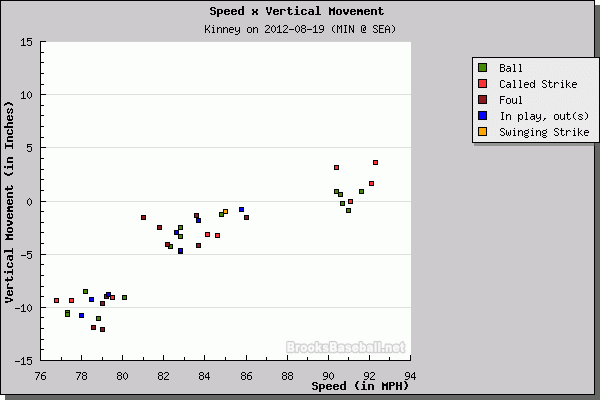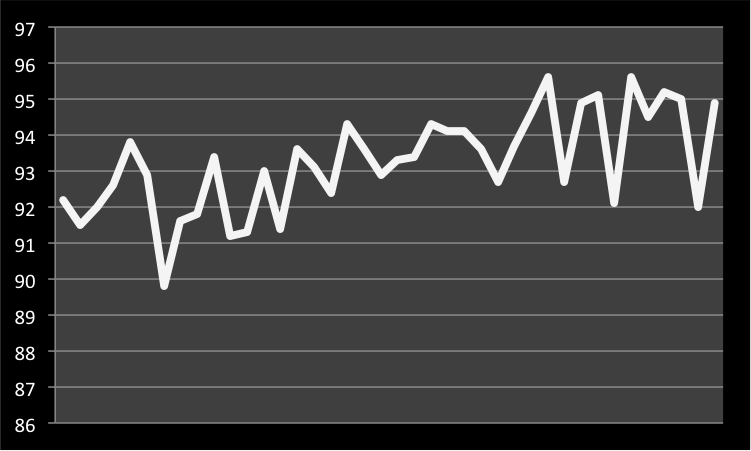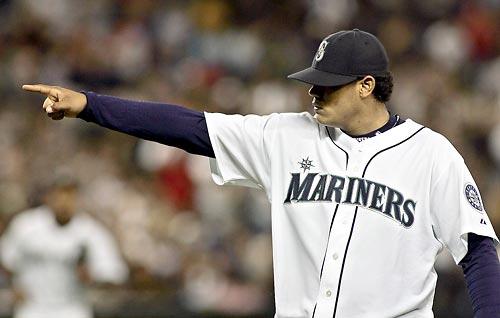Josh Kinney Throws Breaking Balls
Josh Kinney throws a lot of sliders. In fact, Baseball Info Solutions has categorized 56% of the pitches that Josh Kinney has thrown this season as sliders – only three pitchers (min 10 IP) have a higher slider usage rate in baseball this year. So, any time you see Josh Kinney on the mound, you should think “hey, I bet he’s about to throw a slider.”
Well, today, Josh Kinney was asked to face the final nine batters of the game, rather than being used in his normal situational right-handed role. He threw 43 pitches to those nine batters, but the PITCHF/x system only captured 42 of them. Here’s what a PITCHF/x plot of those 42 pitches looks like.
That blob in the middle? Those are his sliders. I count 18 of them – ignore the gameday classifications, as they’re not always great, and are especially not great for Kinney today. Anyway, that’s actually not a ton of sliders, by Josh Kinney standards anyway. But, if you look to the left, you’ll see another sizable blob – those are curve balls, a slightly slower breaking ball that Kinney decided to introduce since he was asked to get some left-handers out. There are 15 of those. That means that 33 of the 42 pitches that PITCHF/x picked up on were breaking balls of some kind.
That’s 79% of his pitches. Josh Kinney threw nearly half as many pitches as a starter does on most days, and only 21% of them were fastballs. Josh Kinney basically just junked his way threw the Twins entire line-up.
This is both amazing and a reason why you shouldn’t get too excited about Josh Kinney’s strikeout rate. If you just focused on that number, you might surmise that he’s just a little command improvement away from being a good reliever. In reality, though, he’s a guy who just throws breaking ball after breaking ball until opposing batters either draw a walk or chase something out of the zone and strike themselves out. As you might imagine, this shtick works a lot better against righties than lefties (since breaking balls diving away from you are harder to hit than ones diving into your wheelhouse), and Kinney’s off-speed based approach actually makes him a pretty decent right-on-right specialist. He’s basically Lucas Luetge flipped around the other way.
There’s nothing wrong with that, but he probably shouldn’t be asked to face nine batters very often.
Game 122, Twins at Mariners
A little late on this, Blake Beavan vs. Samuel Deduno (who?), 1:10 pm.
Ackley 2B-L
Saunders CF-L
Seager 3B-L
Jaso C-L
Montero DH-R
Smoak 1B-B
Thames RF-L
Robinson LF-B
Kawasaki SS-L
Okay, Deduno is not a command/control lefty. Judging from his track record, he appears to be a rather wild journeyman righty, hence the heavily lefthanded lineup.
Game 121, Twins at Mariners
Jason Vargas vs. Scott Diamond, 6:10pm
Franklin Gutierrez starts for Tacoma tonight on a rehab assignment; sounds like he may rejoin the M’s when rosters expand.
Scott Diamond’s a Twins pitcher, which means he’s a command/control lefty.
The line-up:
1: Ackley
2: Robinson
3: Montero (C)
4: Olivo (DH)
5: Seager
6: Smoak
7: Wells
8: Saunders
9: Ryan
SP: Vargas
Hisashi Iwakuma as a Starter
Since moving into the rotation, here are Hisashi Iwakuma’s numbers:
48 IP, 43 H, 17 BB, 42 K, 3.37 ERA, 3.75 xFIP
Hopefully, we’re all well past that whole silly “he doesn’t have Major League stuff” phase, and it should be pretty clear to most everyone now that Iwakuma is a perfectly capable back-end Major League starter. He gets groundballs, he gets strikeouts, and his command has improved with regular work. After he was essentially ostracized for the first several months of 2012, I figured he’d end up going somewhere else next year and show the M’s what they were missing out on. Now that they’ve actually seen it for themselves, it’d probably be worth exploring a 2013 contract extension with him.
With The Big Three all looking like they should probably begin 2013 in the minors as well, the team is still in need of big league starting pitching, and Iwakuma is showing that he is a capable big league starter. It’s too bad it took the organization a few months to figure that out, but now that we’re here, keeping him from getting to free agency is probably a worthwhile goal.
Game 120, Twins at Mariners
Not Felix vs. Not At All Felix, Like Pretty Much the Anti-Felix, 7:10pm
The Minnesota Twins visit Safeco for a three game series and a reminder that, however bleak things look in Seattle, they’re worse in the Twin Cities. Minnesota has the worst record in the American League, and it’s not terribly close. Their opening day payroll exceeded $100 million. While they’ve gotten surprisingly decent years from their oft-injured, highly-compensated stars, Justin Morneau and Joe Mauer, the team’s sunk about $20 million into guys they hoped would stabilize the starting rotation: Carl Pavano, Scott Baker and tonight’s starter, Nick Blackburn. Baker’s out for the year with Tommy John surgery, and Pavano and Blackburn have combined for 156 replacement-level innings.
Amongst all pitchers with at least 80 innings pitched this year, Blackburn has the worst xFIP, the worst FIP, the worst WAR, the worst ERA, the 2nd worst HR/9 (thanks, Tommy Hunter), and the 3rd worst K%. His FIP is comfortably more than double Felix’s (it makes me uncomfortable to even associate Felix with Blackburn’s 2012). Pitch-type run values can be problematic for a variety of reasons, but just for fun: Blackburn’s two-seam fastball (his bread and butter pitch) has been, the worst pitch – any kind of pitch – in baseball this year. Nick Blackburn’s had a sub-par season, is kind of what I’m getting at.
Hisashi Iwakuma’s still given up 1 HR in each MLB start, and while his ground ball rate’s down a tad from his (brief) stint as a reliever, his K% and K:BB ratio’s improved. True, almost all of that’s due to his out-of-nowhere 13 strike-out game against the Jays, but he’s been a solid starter – his RA’s just under 4 over the course of 7 starts. He’s still somewhat homer-prone, though he’s been a far sight better than Blackburn in that department. Still, he’s got to avoid fastball counts, as MLB is simply destroying Iwakuma’s fastballs. His four-seamer’s the pitch he uses most frequently, and when hitters have put it in play, they’ve hit .300 with a slugging percentage of .650. His sinker’s amazing by comparison, but hitters have gone .280/.400 off of that. His slider’s been bad too, as hitters are slugging .571 on it, and when you remember that it’s thrown predominantly to right-handed batters, it looks even worse. Weakness in his four-seam and slider are two direct causes of his poor performance against right-handed batters. Sure, luck (in the form of his freakish HR/FB ratio) has played a role too, but that’s gone both ways (his ERA’s much lower than his FIP, and he’s got what looks like an unsustainable strand rate). He’s an intriguing pitcher, and I could see him adding some real value in 2013, but I’d love to see some real progress in his slider before I contemplate a multi-year free agent deal for Iwakuma.
The line-up:
1: Ackley
2: Saunders
3: Seager
4: Jaso (DH)
5: Smoak
6: Olivo (C)
7: Robinson
8: Thames
9: Ryan
SP: Iwakuma
The M’s made a roster move today, optioning Shawn Kelley to Tacoma to make room for Charlie Furbush, who came off the DL. Kelley’s been quite effective by FIP and K% this year, but he’s struggled a bit if you look at win probability. He’s got the worst Win Probability Added of any player on the team (now that League and Delabar play elsewhere), and he’s got the worst WPA/LI. The reason’s pretty simple: Kelley’s has racked up the most “meltdowns” on the team (again, excluding League), and he has the worst ratio of “shutdowns” to “meltdowns” in the ‘pen (excluding Steve Delabar). (Meltdowns are a great stat-geek alternative to the ‘blown save’ and are calculated as a reliever who dropped his team’s chance of winning by 6% or more in his appearance). I think most stat-savvy fans would argue that the strikeout and strikeout-to-walk ratio numbers are “truer” than the WPA stuff, which is almost 100% the product of sequencing. But even the geekiest of fans were getting nervous when Brandon League came into the game, and I’m pretty sure the M’s coaching staff is feeling the same way about Kelley right now. Brandon League had a FIP of 3.39 with the M’s this year – exactly the same as Kelley’s. I’m sure plenty of people would agree that he was partially – partially – the victim of bad luck, but I don’t recall anyone objecting to his trade. I like Shawn Kelley, and think he’s going to be a solid mid-inning reliever, but I’m not exactly dumbfounded that the M’s chose to send him down instead of Carter Capps. Josh Kinney would’ve been a possible candidate if he had options left, but he doesn’t. And Kinney’s been tougher on righties than Kelley – Kinney’s fanned 40% of RHBs he’s faced, compared to Kelley’s 25%. Shawn Kelley’s probably frustrated right now, and I get that, but I think this has more to do with how deep the M’s are in right-handed relievers. Kelley’s a major league arm who may get the chance to be a 7th inning guy somewhere else next year.
Remember When Felix Was Predictable?
Back in 2007, when Felix was struggling to live up to his talent level, I wrote an open letter to Rafael Chaves, asking him to confront Felix about the predictable patterns he was using to attack hitters. After charting all of his starts, it became very obvious to me what pitch he was going to throw in certain situations, and he followed this pattern almost without fail. If I could figure it out, so could MLB hitters.
You probably know the rest of the story. Chaves got the letter, gave it to Felix, and he gave us some credit a week later after he shutout the A’s and said he tried to mix his pitches better. He would have figured this out on his own, of course, and I have no interest in taking any credit for anything Felix has done since, but it was still nice to see the results match the stuff after some frustrating outings.
Anyway, that’s all ancient history now. We’ve seen Felix develop from a guy who pitches off his fastball into one who uses his whole arsenal, and he really knows how to pitch now. Never was that more evident than yesterday. As Jaso said after the game:
“I’ve been on the Rays before,” Jaso said. “I know their approach against Felix. It’s to hit that fastball and hit it early. You don’t want to go to the secondary stuff because that’s what gets you out.”
Felix just didn’t give the Rays fastballs yesterday, even in situations where you’d almost certainly expect him to throw them.
11 times, he fell behind 1-0. His pitch selection on 1-0 pitches: 5 fastballs, 4 sliders, 2 curves
3 times, he fell behind 2-0. His pitch selection on 2-0 pitches: 1 fastball, 2 sliders
6 times, he fell behind 2-1. His pitch selection on 2-1 pitches: 2 fastballs, 1 slider, 3 curves
He still used his fastball, mostly on the first pitch of an at-bat. 19 of the 27 batters he saw got a first pitch fastball. But, instead of just falling into a pattern of “Fastball Until I get Ahead” followed by “Breaking Balls To Get A Strikeout”, all bets were off after 0-0. You might get a 2-0 slider, or you might get a 0-2 fastball. There was no way to know what Felix was throwing next. And it was awesome to watch.
Felix Hernandez, Pitcher. Far more fun than Felix Hernandez, Stuff Guy.
Breaking Down How Felix Did It
Over at FanGraphs, Bradley Woodrum did a fantastic breakdown of how Felix attacked the Rays yesterday, putting together a series of informative graphics that illustrate just how his approach evolved throughout the game. Seriously, go read this now.
Every Out Of The Perfect Game
MLB.com can be kind of annoying when it comes to online video, but today, they’ve shown how great of an age we really live in – they’ve already spliced up all 27 outs of today’s perfect game into one video. And they made it embeddable. Enjoy.
Felix’s Fastball On Adrenaline
You’ve seen Felix pitch this year at 89-92 with his fastball, and his average fastball velocity has been down compared to past seasons. Lately, though, it has started to come back. Today, once Felix decided to go for the perfect game, it came roaring back. Here is the velocity trend of his fastballs — all pitches labeled as either a four-seam, two-seam, cutter, or sinker by PITCHF/x — in today’s game as the game progressed.
Felix + Adrenaline = Welcome Back, Fastball.



